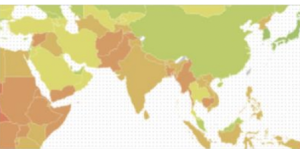
The project is a regional initiative targeting dry land localities within the dry zone of Sri Lanka and the eastern coast of India. In Sri Lanka, the project will focus on districts in the dry zone, while targeted areas in India will be the dry districts within the states of Odisha, Andhra Pradesh and Tamil Nadu. The targeted areas in both countries share similar climate risks, agro-ecological conditions and socio-economic vulnerabilities. Climate change impacts already affecting the project areas in Sri Lanka and India include delayed monsoon rains, increased average temperature leading to more heat stress, more variable rainfall, and increased frequency of heatwaves and droughts, which result in reduced food and water security, as well as adverse effects on human health, natural ecosystems and biodiversity.
In the targeted areas in India, agriculture is primarily rain-fed, with the majority of farmers dependent on the monsoon for irrigating their crops. Over-reliance on the monsoon poses uncertainties for food production and rural incomes as droughts, floods and variation in rainfall pattern greatly affect the agricultural sector. While vulnerability to increased droughts through climate change is widespread throughout Sri Lanka, it is concentrated in the Dry and Intermediate Zones.Changes in the northeast monsoon seasonal rainfall compared to the base line climatology clearly indicate decreasing rainfall, especially in the dry zone. The combination of changed average conditions and increased extreme weather events is resulting in the growing climate risks in the target regions in both India and Sri Lanka.
The project’s main goal is to strengthen the climate change adaptive capacity and food security of vulnerable communities in Sri Lanka’s dry zone and India’s eastern coastal states, utilizing a regional, integrated approach. Leveraging differentiated skills and experience in the two countries, and using participatory and bottom-up approaches, the project will enable vulnerable groups to use last mile climate services to plan and implement targeted adaptation measures best suited for different livelihoods and localities, supplemented by livelihoods diversification and enhanced linkages to existing financial services. A regional feedback loop will provide valuable real-time lessons for scaling up and out, both within and beyond the two countries. The project aims to benefit around 700,000 individuals directly and more than 900,000 indirectly.
| Project Component 1: Enhanced effectiveness of last mile climate services to enable vulnerable communities to manage and adapt to climate variability and change | US$ 3,160,235 |
| Project Component 2: Community based adaptation and diversified livelihoods enabled | US$ 8,548,420 |
| Project execution cost | US$ 1,014,549 |
| Total project cost | US$ 12,723,204 |
| Implementing Entity Project Cycle Management Fee | US$ 1,272,320 |
| Grant Amount | US$ 13,995,524 |
Project Documents
| Attachment | Type | Size |
|---|---|---|
| Project pre-concept | 274 KB | |
| Project concept | 3 MB | |
| Project document | 3 MB |

